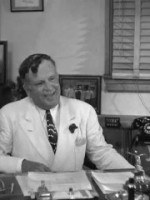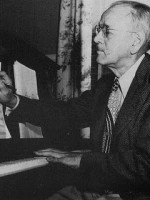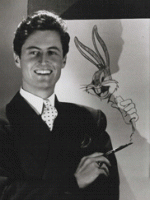Tex Avery is a Actor, Director, Scriptwriter and Animation American born on 26 february 1908 at Taylor (USA)
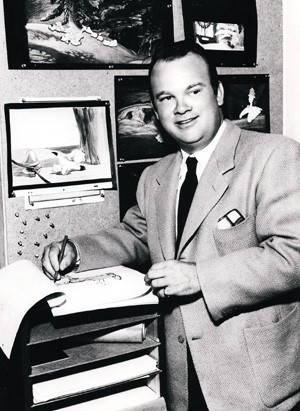
Frederick Bean "Tex" Avery (February 26, 1908 – August 26, 1980) was an American animator, cartoonist, voice actor and director, known for producing animated cartoons during The Golden Age of Hollywood animation. His most significant work was for the Warner Bros. and Metro-Goldwyn-Mayer studios, creating the characters of Bugs Bunny, Daffy Duck, Droopy, Screwy Squirrel, and developing Porky Pig, Chilly Willy (this last one for the Walter Lantz Studio) into the personas for which they are remembered.
Gary Morris described Avery's innovative approach:Above all, [Avery] steered the Warner Bros. house style away from Disney-esque sentimentality and made cartoons that appealed equally to adults, who appreciated Avery's speed, sarcasm, and irony, and to kids, who liked the nonstop action. Disney's "cute and cuddly" creatures, under Avery's guidance, were transformed into unflappable wits like Bugs Bunny, endearing buffoons like Porky Pig, or dazzling crazies like Daffy Duck. Even the classic fairy tale, a market that Disney had cornered, was appropriated by Avery, who made innocent heroines like Red Riding Hood into sexy jazz babes, more than a match for any Wolf. Avery also endeared himself to intellectuals by constantly breaking through the artifice of the cartoon, having characters leap out of the end credits, loudly object to the plot of the cartoon they were starring in, or speak directly to the audience.
Avery's style of directing encouraged animators to stretch the boundaries of the medium to do things in a cartoon that could not be done in the world of live-action film. An often-quoted line about Avery's cartoons was, "In a cartoon you can do anything." He also performed a great deal of voice work in his cartoons, usually throwaway bits (e.g. the Santa Claus seen briefly in Who Killed Who?), but Avery also voiced Junior from George and Junior and occasionally filled in for Bill Thompson as Droopy.
Avery was born to George Walton Avery (1867–1935) and Mary Augusta "Jessie" (née Bean; 1886–1931) in Taylor, Texas. His father was born in Alabama and his mother was born in Chickasaw County, Mississippi. His paternal grandparents were Needham Avery (Civil War veteran; October 8, 1838 – February 20, 1913, buried at Wehadkee Primitive Baptist Church Cemetery, Randolph County, Alabama) and his wife, Lucinda C. Baxly (May 11, 1844 – March 10, 1892). His maternal grandparents were Frederick Mumford Bean (1852 – October 23, 1886) and his wife Minnie Edgar (July 25, 1854 – May 7, 1940). His paternal great-grandparents were John Walton Avery (December 16, 1805 – January 13, 1878, buried at Rock Springs Cemetery, Randolph County, Alabama) and wife Elizabeth Brannon (née Tomme) Avery (October 17, 1809 – October 15, 1895, buried at Mount Pisgah Primitive Baptist Church Cemetery, Stroud, Chambers County, Alabama).
Avery, nicknamed "Tex", "Fred", and "Texas", was raised in his Taylor, Texas, and graduated in 1926 from North Dallas High School. A popular catchphrase at his school was "What's up, doc?", which he would later popularize with Bugs Bunny in the 1940s.
Avery first began his animation career at the Walter Lantz studio in the early 1930s, working on the majority of the Oswald the Lucky Rabbit cartoons from 1931 to 1935. He is shown as 'animator' on the original title card credits on the Oswald cartoons. He later claimed to have directed two cartoons during this time. During some office horseplay at the Lantz studio, a thumbtack flew into Avery's left eye and caused him to lose his sight in that eye. Some speculate it was his lack of depth perception that gave him his unique look at animation and bizarre directorial style.
"Termite Terrace"
Avery migrated to the Leon Schlesinger studio in late 1935 and convinced the fast-talking Schlesinger to let him head his own production unit of animators and create cartoons the way he wanted them to be made. Schlesinger responded by assigning the Avery unit, including animators Bob Clampett and Chuck Jones, to a five-room bungalow at the Warner Bros. Sunset Blvd. backlot. Schlesinger placed the Avery unit there so as not to tip off Avery's predecessor Tom Palmer that he was about to be fired. The Avery unit, assigned to work primarily on the black-and-white Looney Tunes instead of the Technicolor Merrie Melodies, soon dubbed their quarters "Termite Terrace", due to its significant termite population.
"Termite Terrace" later became the nickname for the entire Schlesinger/Warners studio, primarily because Avery and his unit were the ones who defined what became known as "the Warner Bros. cartoon". Their first short, Gold Diggers of '49, is recognized as the first cartoon to make Porky Pig a star, and Avery’s experimentation with the medium continued from there.
According to Martha Sigall, Avery was one of the few directors to visit the ink and paint department. She thinks he liked to see how his cartoons were turning out. He would answer questions and was always in good humor. When some of the artists humorously criticized the wild action in his animated shorts, Avery would take time to explain his rationale. Avery recalled that while working at Warner Bros., they had so much liberty. Nothing was held back as they had hardly any censorship of cartoons.
Creation of Looney Tunes stars
Avery, with the assistance of Clampett, Jones, and the new associate director Frank Tashlin, laid the foundation for a style of animation that dethroned The Walt Disney Studio as the kings of animated short films, and created a legion of cartoon stars whose names still shine around the world today. Avery in particular was deeply involved; a perfectionist, Avery constantly crafted gags for the shorts, periodically provided voices for them (including his trademark belly laugh), and held such control over the timing of the shorts that he would add or cut frames out of the final negative if he felt a gag's timing was not quite right.
Porky's Duck Hunt introduced the character of Daffy Duck, who possessed a new form of "lunacy" and zaniness that had not been seen before in animated cartoons. Daffy was an almost completely out-of-control "darn fool duck" who frequently bounced around the film frame in double-speed, screaming "Hoo-hoo! hoo-hoo" in a high-pitched, sped-up voice provided by the veteran Warner voice artist Mel Blanc, who, with this cartoon, also took over providing the voice of Porky Pig. Avery directed two more Daffy Duck cartoons: Daffy Duck & Egghead and Daffy Duck in Hollywood. Egghead was a character inspired by comedian Joe Penner which would evolve into Elmer Fudd and first appeared in Avery's Egghead Rides Again.
Ben Hardaway, Cal Dalton and Chuck Jones directed a series of shorts which featured a Daffy Duck-like rabbit, created by Ben "Bugs" Hardaway. As is the case with most directors, each puts his own personal stamp on the characters, stories and overall feel of a short. So each of these cartoons treated the rabbit differently. The next to try out the rabbit, known around Termite Terrace as "Bugs's bunny" (named after Hardaway), was Avery. Since the recycling of storylines among the directors was commonplace, "A Wild Hare" was a double throwback. Avery had directed the '37 short, "Porky's Duck Hunt" featuring Porky Pig which introduced "Daffy Duck".
Hardaway remade this as "Porky's Hare Hunt" introducing the rabbit. So Avery went back to the "hunter and prey" framework, and incorporating Jones' "Elmer's Candid Camera", gag for gag, and altering the design of Elmer Fudd. Polishing the timing, and expanding the Groucho Marx smart-aleck attitude already present in "Porky's Hare Hunt", making Bugs a kind of Brooklyn-esque super-cool rabbit who was always in control of the situation and who ran rings around his opponents. Avery has stated that it was very common to refer to folks in Texas as "doc", much like "pal", "dude" or "bud". In A Wild Hare, Bugs adopts this colloquialism when he casually walks up to Elmer, who is "hunting wabbits" and while carefully inspecting a rabbit hole, shotgun in hand, the first words out of Bugs's mouth is a coolly calm, "What's up, doc?". Audiences reacted riotously to the juxtaposition of Bugs's nonchalance and the potentially dangerous situation, and "What's up, doc?" instantly became the rabbit's catchphrase.
Avery ended up directing only four Bugs Bunny cartoons: A Wild Hare, Tortoise Beats Hare, All This and Rabbit Stew, and The Heckling Hare. During this period, he also directed a number of one-shot shorts, including travelogue parodies (The Isle of Pingo Pongo), fractured fairy-tales (The Bear's Tale), Hollywood caricature films (Hollywood Steps Out), and cartoons featuring Bugs Bunny clones (The Crack-Pot Quail).
Avery's tenure at the Schlesinger studio ended in late 1941, when he and the producer quarreled over the ending to The Heckling Hare. In Avery's original version, Bugs and hunting dog were to fall off a cliff three times, milking the gag to its comic extreme. According to a DVD commentary for the cartoon, the historian and animator Greg Ford explained that the problem Schlesinger had with the ending was that, just before falling off the third time, Bugs and the dog were to turn to the screen, with Bugs saying "Hold on to your hats, folks, here we go again!" It is thought that this was the punchline to a well-known risqué joke of the day. The Hollywood Reporter reported on the quarrel on April 2, 1941. Avery was slapped with a four-week, unpaid suspension.
Speaking of Animals
While at Schlesinger, Avery created a concept of animating lip movement to live action footage of animals. Schlesinger was not interested in Avery's idea, so Avery approached Jerry Fairbanks, a friend of his who produced the Unusual Occupations series of short subjects for Paramount Pictures. Fairbanks liked the idea and the Speaking of Animals series of shorts was launched. When Avery left Warner, he went straight to Paramount to work on the first three shorts in the series before joining MGM. The series continued without him, lasting seven years.
Avery at MGM
On September 2, 1941, the Reporter announced that Avery had signed a five-year contract with Metro-Goldwyn-Mayer, where he was to form his own animation unit and direct shorts in Technicolor. By 1942, Avery was in the employ of MGM, working in their cartoon division under the supervision of Fred Quimby. Avery felt that Schlesinger had stifled him. When asked if he missed the Looney Tunes characters, he responded : "Sometimes, but I don't miss anything else. MGM is a heck of better place to work, in every way, and the people here are just as great."
At MGM, Avery's creativity reached its peak. His cartoons became known for their sheer lunacy, breakneck pace, and a penchant for playing with the medium of animation and film in general that few other directors dared to approach. MGM also offered him larger budgets and a higher quality production level than the Warners studio. Plus, his unit was filled with ex-Disney artists such as Preston Blair and Ed Love. These changes were evident in Avery's first short released by MGM, The Blitz Wolf, an Adolf Hitler parody which was nominated for the Academy Award for Best Short Subject (Cartoons) in 1942. Avery's cartoons at MGM somewhat felt like Looney Tunes and Merrie Melodies cartoons done during that same period at Warner Bros., two cartoon series which Avery himself had worked on back then, albeit the Warners' series' gained more popularity than Avery's MGM cartoons.
Avery's best known MGM character debuted in Dumb-Hounded (1943). Droopy (originally "Happy Hound") was a calm, little, slow-moving and slow-talking dog who still won out in the end. He also created a series of risqué cartoons, beginning with Red Hot Riding Hood (also 1943), featuring a sexy female star who never had a set name but has been unofficially referred to as "Red" by fans. Her visual design and voice varied somewhat between shorts. Other Avery characters at MGM included Screwy Squirrel and the Of Mice and Men-inspired duo of George and Junior.
Other MGM cartoons directed by Avery include Bad Luck Blackie, Cellbound, Magical Maestro, Lucky Ducky, Ventriloquist Cat and King-Size Canary. Avery began his stint at MGM working with lush colors and realistic backgrounds, but he slowly abandoned this style for a more frenetic, less realistic approach. The newer, more stylized look reflected the influence of the up-and-coming UPA studio, the need to cut costs as budgets grew higher, and Avery's own desire to leave reality behind and make cartoons that were not tied to the real world of live action. During this period, he made a series of films which explored the technology of the future: The House of Tomorrow, The Car of Tomorrow, The Farm of Tomorrow and TV of Tomorrow (spoofing common live-action promotional shorts of the time). He also introduced a slow-talking wolf character, who was the prototype for MGM associates Hanna-Barbera's Huckleberry Hound character, right down to the voice by Daws Butler.
Avery took a year's sabbatical from MGM beginning in 1950 (to recover from overwork), during which time Dick Lundy, recently arrived from the Walter Lantz studio, took over his unit and made one Droopy cartoon, as well as a string of shorts with an old character, Barney Bear. Avery returned to MGM in October 1951 and began working again. Avery's last two original cartoons for MGM were Deputy Droopy and Cellbound, completed in 1953 and released in 1955. They were co-directed by the Avery unit animator Michael Lah. Lah began directing a handful of CinemaScope Droopy shorts on his own. A burnt-out Avery left MGM in 1953 to return to the Walter Lantz studio.
Post-MGM
Avery's return to the Lantz studio did not last long. He directed four cartoons in 1954–1955: the one-shots Crazy Mixed-Up Pup, Shh-h-h-h-h, I'm Cold and The Legend of Rockabye Point, in which he defined the character of Chilly Willy the penguin. Although The Legend of Rockabye Point and Crazy Mixed-Up Pup were nominated for Academy Awards, Avery left Lantz over a salary dispute, effectively ending his career in theatrical animation.
He turned to animated television commercials, including the Raid commercials of the 1960s and 1970s (in which cartoon insects, confronted by the bug killer, screamed "RAID!" and died flamboyantly) and Frito-Lay's controversial mascot, the Frito Bandito. Avery also produced ads for Kool-Aid fruit drinks starring the Warner Bros. characters he had once helped create during his Termite Terrace days. During the 1960s and 1970s, Avery became increasingly reserved and depressed, although he continued to draw respect from his peers. His final employer was Hanna-Barbera Productions, where he wrote gags for Saturday morning cartoons such as the Droopy-esque Kwicky Koala.
Source : Wikidata
Tex Avery

- Infos
- Photos
- Best films
- Family
- Characters
- Awards
Birth name Frederick Bean Avery
Nationality USA
Birth 26 february 1908 at Taylor (USA)
Death 26 august 1980 (at 72 years) at Burbank (USA)
Nationality USA
Birth 26 february 1908 at Taylor (USA)
Death 26 august 1980 (at 72 years) at Burbank (USA)
Frederick Bean "Tex" Avery (February 26, 1908 – August 26, 1980) was an American animator, cartoonist, voice actor and director, known for producing animated cartoons during The Golden Age of Hollywood animation. His most significant work was for the Warner Bros. and Metro-Goldwyn-Mayer studios, creating the characters of Bugs Bunny, Daffy Duck, Droopy, Screwy Squirrel, and developing Porky Pig, Chilly Willy (this last one for the Walter Lantz Studio) into the personas for which they are remembered.
Gary Morris described Avery's innovative approach:Above all, [Avery] steered the Warner Bros. house style away from Disney-esque sentimentality and made cartoons that appealed equally to adults, who appreciated Avery's speed, sarcasm, and irony, and to kids, who liked the nonstop action. Disney's "cute and cuddly" creatures, under Avery's guidance, were transformed into unflappable wits like Bugs Bunny, endearing buffoons like Porky Pig, or dazzling crazies like Daffy Duck. Even the classic fairy tale, a market that Disney had cornered, was appropriated by Avery, who made innocent heroines like Red Riding Hood into sexy jazz babes, more than a match for any Wolf. Avery also endeared himself to intellectuals by constantly breaking through the artifice of the cartoon, having characters leap out of the end credits, loudly object to the plot of the cartoon they were starring in, or speak directly to the audience.
Avery's style of directing encouraged animators to stretch the boundaries of the medium to do things in a cartoon that could not be done in the world of live-action film. An often-quoted line about Avery's cartoons was, "In a cartoon you can do anything." He also performed a great deal of voice work in his cartoons, usually throwaway bits (e.g. the Santa Claus seen briefly in Who Killed Who?), but Avery also voiced Junior from George and Junior and occasionally filled in for Bill Thompson as Droopy.
Biography
Early yearsAvery was born to George Walton Avery (1867–1935) and Mary Augusta "Jessie" (née Bean; 1886–1931) in Taylor, Texas. His father was born in Alabama and his mother was born in Chickasaw County, Mississippi. His paternal grandparents were Needham Avery (Civil War veteran; October 8, 1838 – February 20, 1913, buried at Wehadkee Primitive Baptist Church Cemetery, Randolph County, Alabama) and his wife, Lucinda C. Baxly (May 11, 1844 – March 10, 1892). His maternal grandparents were Frederick Mumford Bean (1852 – October 23, 1886) and his wife Minnie Edgar (July 25, 1854 – May 7, 1940). His paternal great-grandparents were John Walton Avery (December 16, 1805 – January 13, 1878, buried at Rock Springs Cemetery, Randolph County, Alabama) and wife Elizabeth Brannon (née Tomme) Avery (October 17, 1809 – October 15, 1895, buried at Mount Pisgah Primitive Baptist Church Cemetery, Stroud, Chambers County, Alabama).
Avery, nicknamed "Tex", "Fred", and "Texas", was raised in his Taylor, Texas, and graduated in 1926 from North Dallas High School. A popular catchphrase at his school was "What's up, doc?", which he would later popularize with Bugs Bunny in the 1940s.
Avery first began his animation career at the Walter Lantz studio in the early 1930s, working on the majority of the Oswald the Lucky Rabbit cartoons from 1931 to 1935. He is shown as 'animator' on the original title card credits on the Oswald cartoons. He later claimed to have directed two cartoons during this time. During some office horseplay at the Lantz studio, a thumbtack flew into Avery's left eye and caused him to lose his sight in that eye. Some speculate it was his lack of depth perception that gave him his unique look at animation and bizarre directorial style.
"Termite Terrace"
Avery migrated to the Leon Schlesinger studio in late 1935 and convinced the fast-talking Schlesinger to let him head his own production unit of animators and create cartoons the way he wanted them to be made. Schlesinger responded by assigning the Avery unit, including animators Bob Clampett and Chuck Jones, to a five-room bungalow at the Warner Bros. Sunset Blvd. backlot. Schlesinger placed the Avery unit there so as not to tip off Avery's predecessor Tom Palmer that he was about to be fired. The Avery unit, assigned to work primarily on the black-and-white Looney Tunes instead of the Technicolor Merrie Melodies, soon dubbed their quarters "Termite Terrace", due to its significant termite population.
"Termite Terrace" later became the nickname for the entire Schlesinger/Warners studio, primarily because Avery and his unit were the ones who defined what became known as "the Warner Bros. cartoon". Their first short, Gold Diggers of '49, is recognized as the first cartoon to make Porky Pig a star, and Avery’s experimentation with the medium continued from there.
According to Martha Sigall, Avery was one of the few directors to visit the ink and paint department. She thinks he liked to see how his cartoons were turning out. He would answer questions and was always in good humor. When some of the artists humorously criticized the wild action in his animated shorts, Avery would take time to explain his rationale. Avery recalled that while working at Warner Bros., they had so much liberty. Nothing was held back as they had hardly any censorship of cartoons.
Creation of Looney Tunes stars
Avery, with the assistance of Clampett, Jones, and the new associate director Frank Tashlin, laid the foundation for a style of animation that dethroned The Walt Disney Studio as the kings of animated short films, and created a legion of cartoon stars whose names still shine around the world today. Avery in particular was deeply involved; a perfectionist, Avery constantly crafted gags for the shorts, periodically provided voices for them (including his trademark belly laugh), and held such control over the timing of the shorts that he would add or cut frames out of the final negative if he felt a gag's timing was not quite right.
Porky's Duck Hunt introduced the character of Daffy Duck, who possessed a new form of "lunacy" and zaniness that had not been seen before in animated cartoons. Daffy was an almost completely out-of-control "darn fool duck" who frequently bounced around the film frame in double-speed, screaming "Hoo-hoo! hoo-hoo" in a high-pitched, sped-up voice provided by the veteran Warner voice artist Mel Blanc, who, with this cartoon, also took over providing the voice of Porky Pig. Avery directed two more Daffy Duck cartoons: Daffy Duck & Egghead and Daffy Duck in Hollywood. Egghead was a character inspired by comedian Joe Penner which would evolve into Elmer Fudd and first appeared in Avery's Egghead Rides Again.
Ben Hardaway, Cal Dalton and Chuck Jones directed a series of shorts which featured a Daffy Duck-like rabbit, created by Ben "Bugs" Hardaway. As is the case with most directors, each puts his own personal stamp on the characters, stories and overall feel of a short. So each of these cartoons treated the rabbit differently. The next to try out the rabbit, known around Termite Terrace as "Bugs's bunny" (named after Hardaway), was Avery. Since the recycling of storylines among the directors was commonplace, "A Wild Hare" was a double throwback. Avery had directed the '37 short, "Porky's Duck Hunt" featuring Porky Pig which introduced "Daffy Duck".
Hardaway remade this as "Porky's Hare Hunt" introducing the rabbit. So Avery went back to the "hunter and prey" framework, and incorporating Jones' "Elmer's Candid Camera", gag for gag, and altering the design of Elmer Fudd. Polishing the timing, and expanding the Groucho Marx smart-aleck attitude already present in "Porky's Hare Hunt", making Bugs a kind of Brooklyn-esque super-cool rabbit who was always in control of the situation and who ran rings around his opponents. Avery has stated that it was very common to refer to folks in Texas as "doc", much like "pal", "dude" or "bud". In A Wild Hare, Bugs adopts this colloquialism when he casually walks up to Elmer, who is "hunting wabbits" and while carefully inspecting a rabbit hole, shotgun in hand, the first words out of Bugs's mouth is a coolly calm, "What's up, doc?". Audiences reacted riotously to the juxtaposition of Bugs's nonchalance and the potentially dangerous situation, and "What's up, doc?" instantly became the rabbit's catchphrase.
Avery ended up directing only four Bugs Bunny cartoons: A Wild Hare, Tortoise Beats Hare, All This and Rabbit Stew, and The Heckling Hare. During this period, he also directed a number of one-shot shorts, including travelogue parodies (The Isle of Pingo Pongo), fractured fairy-tales (The Bear's Tale), Hollywood caricature films (Hollywood Steps Out), and cartoons featuring Bugs Bunny clones (The Crack-Pot Quail).
Avery's tenure at the Schlesinger studio ended in late 1941, when he and the producer quarreled over the ending to The Heckling Hare. In Avery's original version, Bugs and hunting dog were to fall off a cliff three times, milking the gag to its comic extreme. According to a DVD commentary for the cartoon, the historian and animator Greg Ford explained that the problem Schlesinger had with the ending was that, just before falling off the third time, Bugs and the dog were to turn to the screen, with Bugs saying "Hold on to your hats, folks, here we go again!" It is thought that this was the punchline to a well-known risqué joke of the day. The Hollywood Reporter reported on the quarrel on April 2, 1941. Avery was slapped with a four-week, unpaid suspension.
Speaking of Animals
While at Schlesinger, Avery created a concept of animating lip movement to live action footage of animals. Schlesinger was not interested in Avery's idea, so Avery approached Jerry Fairbanks, a friend of his who produced the Unusual Occupations series of short subjects for Paramount Pictures. Fairbanks liked the idea and the Speaking of Animals series of shorts was launched. When Avery left Warner, he went straight to Paramount to work on the first three shorts in the series before joining MGM. The series continued without him, lasting seven years.
Avery at MGM
On September 2, 1941, the Reporter announced that Avery had signed a five-year contract with Metro-Goldwyn-Mayer, where he was to form his own animation unit and direct shorts in Technicolor. By 1942, Avery was in the employ of MGM, working in their cartoon division under the supervision of Fred Quimby. Avery felt that Schlesinger had stifled him. When asked if he missed the Looney Tunes characters, he responded : "Sometimes, but I don't miss anything else. MGM is a heck of better place to work, in every way, and the people here are just as great."
At MGM, Avery's creativity reached its peak. His cartoons became known for their sheer lunacy, breakneck pace, and a penchant for playing with the medium of animation and film in general that few other directors dared to approach. MGM also offered him larger budgets and a higher quality production level than the Warners studio. Plus, his unit was filled with ex-Disney artists such as Preston Blair and Ed Love. These changes were evident in Avery's first short released by MGM, The Blitz Wolf, an Adolf Hitler parody which was nominated for the Academy Award for Best Short Subject (Cartoons) in 1942. Avery's cartoons at MGM somewhat felt like Looney Tunes and Merrie Melodies cartoons done during that same period at Warner Bros., two cartoon series which Avery himself had worked on back then, albeit the Warners' series' gained more popularity than Avery's MGM cartoons.
Avery's best known MGM character debuted in Dumb-Hounded (1943). Droopy (originally "Happy Hound") was a calm, little, slow-moving and slow-talking dog who still won out in the end. He also created a series of risqué cartoons, beginning with Red Hot Riding Hood (also 1943), featuring a sexy female star who never had a set name but has been unofficially referred to as "Red" by fans. Her visual design and voice varied somewhat between shorts. Other Avery characters at MGM included Screwy Squirrel and the Of Mice and Men-inspired duo of George and Junior.
Other MGM cartoons directed by Avery include Bad Luck Blackie, Cellbound, Magical Maestro, Lucky Ducky, Ventriloquist Cat and King-Size Canary. Avery began his stint at MGM working with lush colors and realistic backgrounds, but he slowly abandoned this style for a more frenetic, less realistic approach. The newer, more stylized look reflected the influence of the up-and-coming UPA studio, the need to cut costs as budgets grew higher, and Avery's own desire to leave reality behind and make cartoons that were not tied to the real world of live action. During this period, he made a series of films which explored the technology of the future: The House of Tomorrow, The Car of Tomorrow, The Farm of Tomorrow and TV of Tomorrow (spoofing common live-action promotional shorts of the time). He also introduced a slow-talking wolf character, who was the prototype for MGM associates Hanna-Barbera's Huckleberry Hound character, right down to the voice by Daws Butler.
Avery took a year's sabbatical from MGM beginning in 1950 (to recover from overwork), during which time Dick Lundy, recently arrived from the Walter Lantz studio, took over his unit and made one Droopy cartoon, as well as a string of shorts with an old character, Barney Bear. Avery returned to MGM in October 1951 and began working again. Avery's last two original cartoons for MGM were Deputy Droopy and Cellbound, completed in 1953 and released in 1955. They were co-directed by the Avery unit animator Michael Lah. Lah began directing a handful of CinemaScope Droopy shorts on his own. A burnt-out Avery left MGM in 1953 to return to the Walter Lantz studio.
Post-MGM
Avery's return to the Lantz studio did not last long. He directed four cartoons in 1954–1955: the one-shots Crazy Mixed-Up Pup, Shh-h-h-h-h, I'm Cold and The Legend of Rockabye Point, in which he defined the character of Chilly Willy the penguin. Although The Legend of Rockabye Point and Crazy Mixed-Up Pup were nominated for Academy Awards, Avery left Lantz over a salary dispute, effectively ending his career in theatrical animation.
He turned to animated television commercials, including the Raid commercials of the 1960s and 1970s (in which cartoon insects, confronted by the bug killer, screamed "RAID!" and died flamboyantly) and Frito-Lay's controversial mascot, the Frito Bandito. Avery also produced ads for Kool-Aid fruit drinks starring the Warner Bros. characters he had once helped create during his Termite Terrace days. During the 1960s and 1970s, Avery became increasingly reserved and depressed, although he continued to draw respect from his peers. His final employer was Hanna-Barbera Productions, where he wrote gags for Saturday morning cartoons such as the Droopy-esque Kwicky Koala.
Usually with
Filmography of Tex Avery (88 films)
Actor
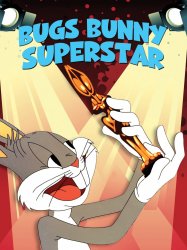
Bugs Bunny: Superstar (1975)
, 7minutesOrigin USA
Genres Comedy, Documentary, Animation
Themes Documentary films about business, Documentary films about the visual arts, Documentary films about the film industry, Children's films
Actors Bob Clampett, Tex Avery, Friz Freleng, Orson Welles, Mel Blanc
Roles Himself
Rating69%





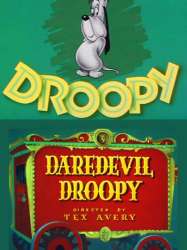
Daredevil Droopy (1951)
, 6minutesDirected by Tex Avery
Origin USA
Genres Comedy, Animation
Themes Films about animals, Films about dogs, Mise en scène d'un mammifère
Actors Bill Thompson, Tex Avery, Daws Butler, Shepard Menken
Roles Spike (voice) (uncredited)
Rating70%





When a circus arrives to town, it features it's famous attractions including "The Great Barko and His Famous Acrobatic Dogs". And under the commertial posters an advertisement stands, titled "Dare Devil Dog Wanted", advertising a job for Barko's new dog-acrobats, under the condition "Must be Fearless!". This attracts both Droopy and Spike's attention to apply for the job. Satisfied with the reply from the two dogs, Barko decides to put the situation on the competitive basis: "The one that gives me the best performance in strength and daring, gets the job!", to which the dogs agree. During every tryouts - "see Simpson the Strong Man" test of strength, ringing the bell, "Pop the Balloons" shooting, "See a Woman Sawed in Half", "The Flying Human" flight test with a propeller on the head, riding a car through a sollid brick wall, "The Sharp Shooter", juggling, riding on a motorcycle through a ring of fire, flying on the trapeze, tightrope-walking, figure skating and "The Human Bullet" shoothing out of the cannon - Spike tries to overbest Droopy and sabotage his performances, to which he fails every time and gets himself injured a couple of times. During Droopy's final act, Spike tryes to sabotage the other again, by burning his foot with a matchstick. But this leads Droopy to perform faster, leaving the audience to applaud and gives him a minor burnt on the foot. Impressed with Droopy's successful performances, Barko hires him to be one of his Acrobatic Dogs. Outraged, Spike tries to cut the pole and timber it on both Droopy and Barko, but instead - it lands on Spike, leaving him the loser.

Bad Luck Blackie (1949)
, 7minutesDirected by Tex Avery
Origin USA
Genres Comedy, Animation
Actors Tex Avery, William Hanna
Roles Large Dog (voice) (uncredited)
Rating75%





Le scénario est basé sur la superstition qui indique que croiser le chemin d'un chat noir porte malheur. Un gros chien martyrise un petit chat, à qui un chat noir vient en aide quand il l'appelle au secours.
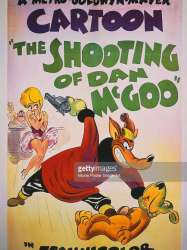
The Shooting of Dan McGoo (1945)
, 8minutesDirected by Tex Avery
Origin USA
Genres Comedy, Animation
Themes Films about animals, Films about dogs, Mise en scène d'un mammifère
Actors Bill Thompson, Tex Avery, Frank Graham, Bea Benaderet, Paul Frees
Rating74%





This starts off as an adaptation of Robert W. Service's poem in spoof of The Shooting of Dan McGrew, complete with a literal depiction of a man with one foot in the grave, but when Dan McGoo turns out to be Droopy, it turns into another Droopy-versus-the Wolf/Wolf-goes-ape-for-the-girl gagfest.

Wild and Woolfy (1945)
, 7minutesDirected by Tex Avery
Origin USA
Genres Comedy, Animation, Western
Themes Films about animals, Films about dogs, Mise en scène d'un mammifère
Actors Paul Frees, Tex Avery, Bea Benaderet, Bill Thompson, Pinto Colvig
Rating71%





In this western-themed cartoon, the Big Bad Wolf, now playing a cowboy criminal called "Joe" Wolf in this cartoon, kidnaps the cowgirl singer, Red (played by Red Hot from Red Hot Riding Hood) from Rig-R-Mortis saloon, where their motto is "Come in and get stiff." Droopy and a posse of cowboys doggedly follow him all over the Great Plains (mainly Droopy), but the wolf is far ahead. However, like in the previous cartoons, Droopy shows up in the places the wolf doesn't expect, forcing him to call for the waiter to keep Droopy away from him.

Who Killed Who? (1943)
, 8minutesDirected by Tex Avery
Origin USA
Genres Drama, Comedy, Animation
Themes Serial killer films
Actors Robert Emmett O'Connor, Billy Bletcher, Tex Avery, Sara Berner, Kent Rogers, Richard Haydn
Roles Santa Claus (voice) (uncredited)
Rating73%





A live-action host (Robert Emmett O'Connor) opens with a disclaimer about the nature of the cartoon, namely, that the short is meant to "prove beyond the shadow of a doubt that crime does not pay."

Hold the Lion, Please (1942)
, 8minutesDirected by Chuck Jones
Origin USA
Genres Comedy, Animation
Themes Films about animals, Mise en scène d'un lapin ou d'un lièvre, Films about lions, Court métrage de Bugs Bunny, Children's films, Mise en scène d'un mammifère
Actors Mel Blanc, Tedd Pierce, Tex Avery
Roles Hippo (voice) (uncredited)
Rating69%





Dans une forêt tropicale, les animaux (un hippopotame, une girafe, un singe) se moquent ouvertement du lion, supposé être le « roi de la jungle ». En effet, le lion en question est complètement bête et incapable. Mais piqué au vif, il cherche à prouver qu'il mérite ce titre en chassant un autre animal, un lapin. Pour son malheur, il se trouve que ce lapin est Bugs Bunny. Le lion essaye d'attirer le lapin avec une carotte tout en l'appelant « bunny » (qu'il prononce « pony »). Bugs indique sa présence par un panneau de signalisation de passage de train où est inscrit : « rabbit tracks » . Le lion voit les empreintes de pattes de Bugs, puis une voie de chemin de fer où déboule Bugs dans un nuage de fumée (jeu de mot avec « tracks » : les traces de lapin et les rails du train). Bugs vole la carotte au passage. Le lion lui court après, se trompe de voie (revient en arrière sur l'aiguillage d'un tronçon de chemin de fer), se retrouve avec le lapin dans les pattes en passant à travers un arbre creux. Pendant que Bugs sort sa réserve personnelle de carottes (sous forme d'un étui à cigares), le lion sort ses griffes une à une... la dernière se trouve être une lame tire-bouchon ! Le lion, honteux de son penchant pour l'alcool, la replie prestement. Le lapin, lui, hume une des carottes comme un cigare. Il la présente au lion, qui donne un coup de patte, la découpant en rondelles. Le lapin en avale une avec gourmandise. Il remue ses oreilles. Le lion tente de l'imiter sans y parvenir, et s'énerve. Le lapin, en discutant encore, dit qu'il est supposé avoir peur. Il mime la peur et réussit à s'enfuir avec des cris et des poses de cabotin. Le lion le retrouve chantant et déguisé en ramasseuse de carottes « poétique », avec un grand chapeau de paille. Bugs remarque le lion qui s'approche en rampant. Aussitôt, le lion fait mine de « nager » nonchalamment. Puis il bondit sur le lapin, est coiffé du chapeau au passage. Bugs Bunny se sauve, plonge dans son terrier. Il en ressort avec une porte. Il ouvre au lion qui y frappe, se moque de son chapeau, lui montre son reflet dans un miroir. Le lion en rit aussi. Le lapin en profite pour déplacer la porte. Le lion croit qu'il est enfermé et essaye d'enfoncer la porte. Le lapin l'ouvre au dernier moment, le lion est emporté dans son élan dans le décor. Il revient brusquement et tient enfin le lapin sous la menace de sa patte griffue, quand un coup de téléphone l'interrompt : c'est son épouse qui l'oblige à rentrer. Le lion abandonne Bugs, qui rit de voir le lion ne pas être le chef, même chez lui. Alors qu'il se vante devant le public de l'être, apparaît M Bugs Bunny dans une jupe. Bugs file doux et rentre dans le terrier conjugal en rampant. « Qui porte la culotte dans cette famille ? », demande-t-elle.
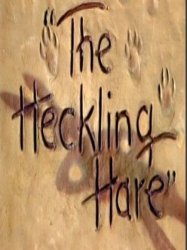
The Heckling Hare (1941)
, 7minutesDirected by Tex Avery
Origin USA
Genres Comedy, Animation
Themes Films about animals, Films about dogs, Mise en scène d'un lapin ou d'un lièvre, Court métrage de Bugs Bunny, Children's films, Mise en scène d'un mammifère
Actors Mel Blanc, Gérard Surugue, Tex Avery, Kent Rogers
Roles Willoughby (voice) (uncredited)
Rating71%





Un chien (Willoughby) est en train de pister Bugs et commence à creuser afin de le trouver. Après que Bugs lui ait fait son traditionnel « Euh, quoi de neuf docteur ? », le chien se fait piéger avec le coup du miroir et se fait assommer par Bugs. Ils continuent leur poursuite dans un étang avant que Bugs ne lui glisse une tomate dans la main, lui faisant croire que le chien a écrasé le lapin. Ce dernier creuse un trou qui débouche sur un précipice. Le chien tombe en nous promettant d'être plus prudent, tandis que Bugs, en se moquant de lui, tombe lui aussi dans le trou. Commence une série de hurlements qui se poursuivent tout au long de la longue chute des deux protagonistes. Mais quelques mètres avant de percuter le sol, ils « freinent » et se retrouvent saufs, juste pour se moquer du public.
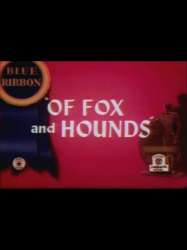
Of Fox and Hounds (1940)
, 9minutesDirected by Tex Avery
Origin USA
Genres Comedy, Animation
Actors Tex Avery, Mel Blanc
Roles Willoughby (voice) (uncredited)
Rating67%





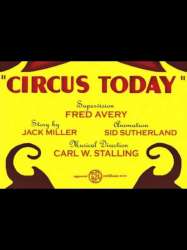
Circus Today (1940)
Directed by Tex Avery
Origin USA
Genres Comedy, Animation
Actors Tex Avery, Mel Blanc
Roles Circus Bandmaster (voice) (uncredited)
Rating65%






A Day at the Zoo (1939)
, 7minutesDirected by Tex Avery
Origin USA
Genres Comedy, Animation
Actors Tex Avery, Mel Blanc, Robert C. Bruce
Roles Other Elk Named Bill (voice) (uncredited)
Rating68%





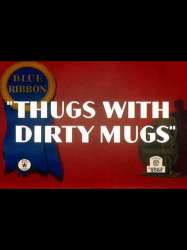
Thugs with Dirty Mugs (1939)
Directed by Tex Avery
Origin USA
Genres Comedy, Crime, Animation
Actors Mel Blanc, Tex Avery
Roles Ed. G. Robemsome as Killer Diller
Rating68%





Il s'agit d'une parodie loufoque des films de "Tough Guys" (Les durs, les gangsters). On y voit les douteux exploits d'une bande de bouledogues anthropomorphes braquant des banques, se livrant à des casses, montant un "coup fumant" pour voler les bijoux d'une actrice célèbre, Lott'a Jewels (Desta de Bijoux).
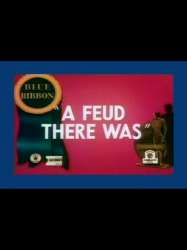
A Feud There Was (1938)
, 8minutesDirected by Tex Avery
Origin USA
Genres Comedy, Animation
Themes Children's films
Actors Tex Avery, Tim Spencer, Roy Rogers, Sara Berner, Danny Webb, Mel Blanc
Roles Weaver Dude / Weaver Guy with Gun (voice)
Rating65%





Two feuding families of stereotypical hillbillies, the Weavers and the McCoys, spend their time taking potshots at each other. At one point, a McCoy asks if there are any Weavers in the movie audience. One man, shown as a silhouette against the screen, answers in the affirmative, and the McCoy takes a shot at him.

The Penguin Parade (1938)
Directed by Tex Avery
Origin USA
Genres Comedy, Animation
Actors Mel Blanc, Tex Avery
Roles Walrus (voice)
Rating60%






Count Me Out (1938)
Directed by Ben Hardaway, Cal Dalton
Origin USA
Genres Comedy, Animation
Actors Tex Avery, Mel Blanc
Roles Fight Referee
Rating60%





 Connection
Connection

